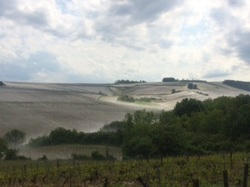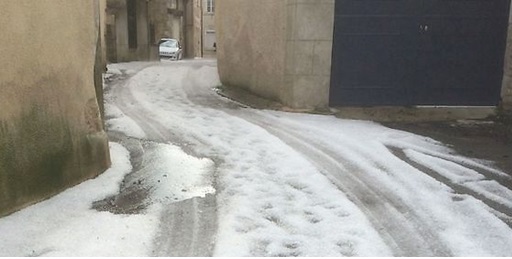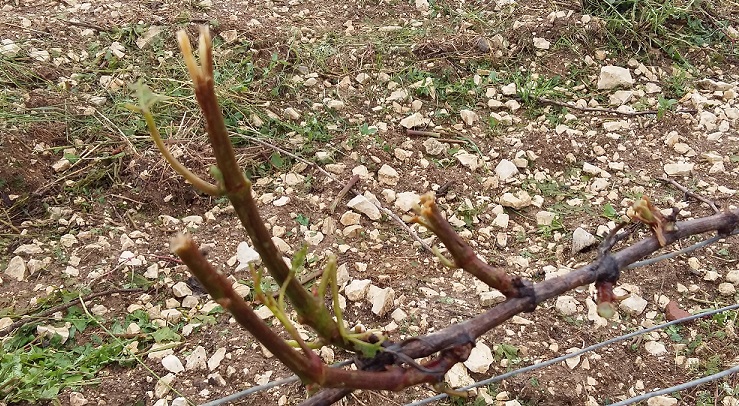
DEVASTING HAIL IN FRANCE MAY 27
A little over a month after frost caused considerable damage to buds in Chablis, Burgundy and the Loire, and two weeks after hail ravaged vines in the north of Chablis around Maligny, on Friday, May 27 a violent hailstorm struck Préhy, Courgis, Chitry, and St Bris.
Hail also did considerable damage over the weekend in Chiroubles, Fleurie, Régnié, and Morgon…as well as in Cognac and Madiran.
Olivier Morin in Chitry had already lost 70% of his 2016 crop to the late April frost; on Friday he lost what was left. The hail fell for 20 minutes and when it stopped, “there was not a single baguette left”. He will not be harvesting in 2016 and the damage to the vines was such that the 2017 harvest is severely compromised. Olivier said he did not know what wood he will have on the vines to prune for 2017. His 88 year old grandfather told him he had never seen a hailstorm of such intensity. After the storm, there were almost 10 inches of hail on the ground.
Thomas Pico of Somaine Pattes Loup, who two weeks ago was relieved that he had escaped the hail, was devasted when I spoke with him yesterday. “Catastrophique” was the word he used to describe the situation. “The next two years will be a question of survival. There will certainly be domains that go out of business.” He has already laid off many of his vineyard workers.
I was in Chablis on Saturday morning to visit a new Chablis domain with which I have started to work. Of their 14.4 hectares of vines, only 1.20 hectares escaped the hail.
In Saint-Bris, Marie Goisot Bellot reported that of their 30 hectares, there was less than one hectare in which there were still some leaves on the vines. To make matters even worse, as it has been raining steadily since Saturday, they have been unable to get into the vineyards to treat the damaged vines.
The constant rain is increasing the risk of mildew and the risk of poor flowering in June.
In the Beaujolais, between 1,000 and 1,500 hectares were hit by hail over the weekend. Paul-Henri Thillardon said “there is nothing left in my vineyards of Chiroubles. “ Vineyards in Fleurie, Régnié and parts of Morgon were also badly damaged.
"I was desolate and afraid, and full of woe and terror".
"We were...living in a world of doom and gloom...where storms raged and wolves scratched at the door."
St Bris streets after the hail storm May 27 and vine ripped up by hail
Cliquer ici pour modifier.
A little over a month after frost caused considerable damage to buds in Chablis, Burgundy and the Loire, and two weeks after hail ravaged vines in the north of Chablis around Maligny, on Friday, May 27 a violent hailstorm struck Préhy, Courgis, Chitry, and St Bris.
Hail also did considerable damage over the weekend in Chiroubles, Fleurie, Régnié, and Morgon…as well as in Cognac and Madiran.
Olivier Morin in Chitry had already lost 70% of his 2016 crop to the late April frost; on Friday he lost what was left. The hail fell for 20 minutes and when it stopped, “there was not a single baguette left”. He will not be harvesting in 2016 and the damage to the vines was such that the 2017 harvest is severely compromised. Olivier said he did not know what wood he will have on the vines to prune for 2017. His 88 year old grandfather told him he had never seen a hailstorm of such intensity. After the storm, there were almost 10 inches of hail on the ground.
Thomas Pico of Somaine Pattes Loup, who two weeks ago was relieved that he had escaped the hail, was devasted when I spoke with him yesterday. “Catastrophique” was the word he used to describe the situation. “The next two years will be a question of survival. There will certainly be domains that go out of business.” He has already laid off many of his vineyard workers.
I was in Chablis on Saturday morning to visit a new Chablis domain with which I have started to work. Of their 14.4 hectares of vines, only 1.20 hectares escaped the hail.
In Saint-Bris, Marie Goisot Bellot reported that of their 30 hectares, there was less than one hectare in which there were still some leaves on the vines. To make matters even worse, as it has been raining steadily since Saturday, they have been unable to get into the vineyards to treat the damaged vines.
The constant rain is increasing the risk of mildew and the risk of poor flowering in June.
In the Beaujolais, between 1,000 and 1,500 hectares were hit by hail over the weekend. Paul-Henri Thillardon said “there is nothing left in my vineyards of Chiroubles. “ Vineyards in Fleurie, Régnié and parts of Morgon were also badly damaged.
"I was desolate and afraid, and full of woe and terror".
"We were...living in a world of doom and gloom...where storms raged and wolves scratched at the door."
St Bris streets after the hail storm May 27 and vine ripped up by hail
Cliquer ici pour modifier.



 RSS Feed
RSS Feed